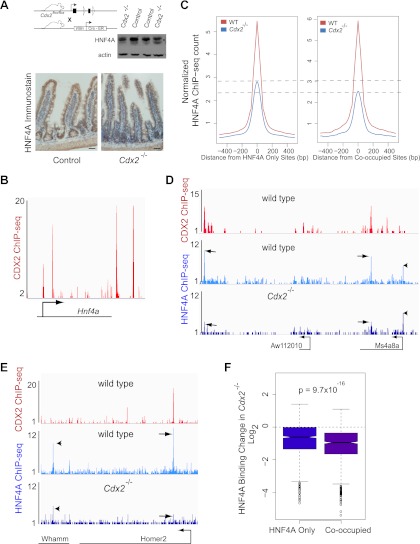Fig 5.
CDX2 is necessary for HNF4A to bind intestinal epithelial cell DNA at cooccupied regions. (A) Immunoblotting and immunohistochemical evidence that HNF4A levels are reduced, approximately by half, in Cdx2−/− intestinal epithelium. (B) Four prominent CDX2 binding sites are observed in a 40-kb window at the murine Hnf4a locus, suggesting direct effects on Hnf4a expression (P < 10−5). (C) Composite plots of ChIP-Seq data from WT and Cdx2−/− intestinal cells, showing HNF4A occupancy at all regions where HNF4A binds DNA without (left box) or with (right box) nearby CDX2 binding. Aggregate HNF4A binding to DNA is reduced, probably owing to lower protein levels, and the compromise is substantially larger at sites cooccupied by CDX2 (right box). Dotted lines mark the difference in average HNF4A peak heights in WT and Cdx2−/− intestines. (D and E) Selective losses in HNF4A binding are shown at representative regions containing both HNF4A-only and cooccupied sites (D, chromosome 19 position 11085000 to 11160000; E, chromosome 7 position 88720000 to 88856000). In Cdx2−/− cells, HNF4A occupancy is affected less or not at all at sites without CDX2 binding (arrowheads) and severely compromised at sites where both TFs normally cooccupy DNA (arrows). (F) Statistical evidence (Mann-Whitney test) that changes in HNF4A binding in the absence of CDX2 are more severe at cooccupied than at singly bound sites.

